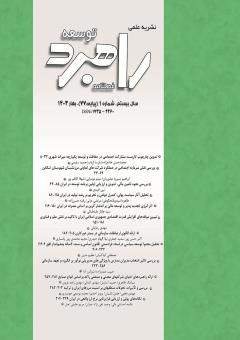بررسی تاثیر انتخاب مدیران مدارس با ویژگی های مدیریتی نوآور بر انگیزه و تعهد سازمانی
محورهای موضوعی :
1 - مربی(دکتری) گروه علوم تربیتی، واحد سلماس، دانشگاه آزاد اسلامی، سلماس، ایران
2 - عضو هیئت علمی دانشکده علوم تربیتی، دانشگاه آتاترک، ترکیه
کلید واژه: کلید واژه: مدیران با ویژگی های مدیریتی نوآور, انگیزه, تعهد سازمانی معلمان,
چکیده مقاله :
چكيده هدف از پژوهش حاضر بررسی میزان تاثیر انتخاب مدیران با ویژگی های مدیریتی نوآور بر انگیزه و تعهد سازمانی معلمان است. نوع پژوهش به لحاظ روش، توصیفی، از نوع همبستگی بوده و به لحاظ هدف کاربردی است. جامعه آماری این پژوهش را کلیه معلمان آموزش و پرورش شهر خوی در سال 1401-1402 تشکیل دادند که تعداد 215 نفر به صورت تصادفی بر اساس فرمول کوکران انتخاب شدند. جهت گردآوری داده ها از پرسشنامه های تعهد سازمانی مودودی، استیرز و پورتر در سال (1979)، نوآوری امید و همکاران (2002) و انگیزه لاورونس و جردن(2009) استفاده گردید. اطلاعات به دست آمده از این پژوهش با استفاده از نرم افزار SPSS 20 و با بکارگیری آمار توصیفی(میانگین ،انحراف معیار) و آمار استنباطی (آزمون ضریب همبستگی پیرسون و رگرسیون چند گانه گام به گام) مورد بررسی و تحلیل قرار گرفتند. نتایج نشان داد که بین متغیرهای پیش بین و ملاک رابطه معناداری وجود دارد. همچنین نتایج رگرسیونی نیز نشان داد که مجموع متغیرهای پیش بین 33/0 R2= از واریانس متغیر ملاک را تبیین و پیش بینی می کنند یعنی متغیرهای پیش بین 33 درصد نمره ویژگی های مدیریتی نوآور را تبیین می کنند. امید به معاشرت 15درصد، امید به قدرت 11درصد، ترس از شکست 3 درصد، تعهد عاطفی 2 درصد و تعهد مستمر نیز 2 درصد از تغییرات ویژگی های مدیریتی نوآور را پیش بینی می کنند. میزان F مشاهده شده برای متغیرهای پیش بین در سطح 001/0 معنادار است. لذا می توان نتیجه گرفت که انگیزه و تعهد سازمانی در میزان ویژگی های مدیریتی نوآور نقش دارند.
The purpose of this research was to investigate the impact of selecting managers with innovative management characteristics on the motivation and organizational commitment of teachers. The type of research is correlational in terms of descriptive method and it is applied in terms of purpose. The statistical population of this research was made up of all the education workers of Khoy city in 1401-1402, and 215 people were randomly selected based on Cochran's formula. In order to collect data, organizational commitment questionnaires by Maududi, Steers and Porter in (1979), Omid et al.'s innovation (2002) and Lawrence and Jordan's motivation (2009) were used. The data obtained from this research were analyzed using SPSS 17 software and using descriptive statistics (mean, standard deviation) and inferential statistics (Pearson's correlation coefficient test and step-by-step multiple regression). The results showed that there is a significant relationship between the predictor variables and the criterion, also the regression results also showed that the sum of the predictor variables explained and predicted R2=0.33 of the variance of the criterion variable, that is, the predictor variables accounted for 33% of the characteristics score. They explain innovative management. Hope for companionship 15%, hope for power 11%, fear of failure 3%, emotional commitment 2% and continuous commitment predict 2% of changes in innovative management characteristics. The observed F level for predictor variables is significant at the 0.001 level. Therefore, it can be concluded that motivation and organizational commitment play a role in the level of innovative management characteristics.
